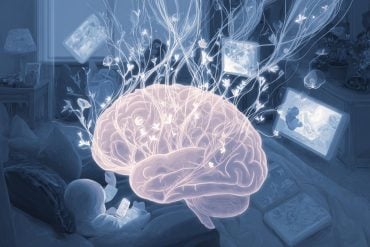Summary: For 25 years, scientists have studied “SuperAgers”—people aged 80 and above whose memory rivals those decades younger. Research reveals that their brains either resist Alzheimer’s-related plaques and tangles or remain resilient despite having them.
These individuals maintain a youthful brain structure, with a thicker cortex and unique neurons linked to memory and social skills. Insights from their biology and behavior could inspire new strategies to protect cognitive health into late life.
Key Facts
- Exceptional Memory: SuperAgers score like 50–60-year-olds on memory tests despite being 80+.
- Brain Structure: They have thicker cortex regions and unique neurons linked to social and memory functions.
- Cognitive Protection: Resistance or resilience to Alzheimer’s pathology helps preserve function.
Source: Northwestern University
For 25 years, scientists at Northwestern Medicine have been studying individuals aged 80 and older — dubbed “SuperAgers” — to better understand what makes them tick.
These unique individuals, who show outstanding memory performance at a level consistent with individuals who are at least three decades younger, challenge the long-held belief that cognitive decline is an inevitable part of aging.

Over the quarter-century of research, the scientists have seen some notable lifestyle and personality differences between SuperAgers and those aging typically — such as being social and gregarious — but “it’s really what we’ve found in their brains that’s been so earth-shattering for us,” said Dr. Sandra Weintraub, a professor of psychiatry and behavioral sciences and neurology at Northwestern University Feinberg School of Medicine.
By identifying biological and behavioral traits associated with SuperAging, the scientists hope to uncover new strategies to promote cognitive resilience and delay or prevent Alzheimer’s and other diseases that cause cognitive decline and dementia.
“Our findings show that exceptional memory in old age is not only possible but is linked to a distinct neurobiological profile. This opens the door to new interventions aimed at preserving brain health well into the later decades of life,” said Weintraub, corresponding author of a new paper summarizing the findings.
The paper will be published in a perspective piece in Alzheimer’s & Dementia: The Journal of the Alzheimer’s Association as part of the journal’s special issue commemorating the 40th anniversary of the National Institute on Aging’s Alzheimer’s Disease Centers Program and the 25th anniversary of the National Alzheimer Coordinating Center.
SuperAger brains are resilient, resistant
The term “SuperAger” was coined by Dr. M. Marsel Mesulam, who founded the Mesulam Center for Cognitive Neurology and Alzheimer’s Disease at Northwestern in the late 1990s.
Since 2000, a cohort of 290 SuperAger participants has passed through the Mesulam Center’s doors, and the scientists have autopsied 77 donated SuperAger brains. Some of the brains contained amyloid and tau proteins (also known as plaques and tangles), which are known to play key roles in the progression of Alzheimer’s disease, but others didn’t develop any.
“What we realized is there are two mechanisms that lead someone to become a SuperAger,” Weintraub said. “One is resistance: they don’t make the plaques and tangles. Two is resilience: they make them, but they don’t do anything to their brains.”
Other key findings:
- Exceptional memory performance: SuperAgers score at least 9 out of 15 on a delayed word recall test — on par with individuals in their 50s and 60s.
- Youthful brain structure: Unlike typically aging brains, SuperAgers show no significant thinning of their cortex — the outer layer of the brain — and even have a thicker anterior cingulate cortex than younger adults. This crucial region of the brain plays a significant role in integrating information related to decision-making, emotion and motivation.
- Unique cellular traits: SuperAgers have more von economo neurons, which are specialized cells linked to social behavior, and larger entorhinal neurons, which are critical for memory, than their typically aging peers.
- Sociability as a common trait: Despite having diverse lifestyles and varying approaches to exercise, SuperAgers tend to be highly social and report strong interpersonal relationships.
‘Brain donation can offer scientific immortality’
At the Mesulam Center, SuperAgers are evaluated annually and may choose to donate their brains for post-mortem evaluation by Northwestern scientists.
“Many of the findings from this paper stem from the examination of brain specimens of generous, dedicated SuperAgers who were followed for decades,” said co-author Dr. Tamar Gefen, associate professor of psychiatry and behavioral sciences at Feinberg, director of Feinberg’s Laboratory for Translational Neuropsychology and a neuropsychologist at the Mesulam Center.
“I am constantly amazed by how brain donation can enable discovery long after death, offering a kind of scientific immortality.”
Learn more about how to join the SuperAger research registry.
The perspective piece is titled, “The First 25 Years of the Northwestern SuperAging Program.” Other Northwestern authors include Dr. Mesulam and Changiz Geula, research professor of cell and developmental biology and neuroscience at Feinberg and a member of the Mesulam Center.
About this aging and memory research news
Author: Kristin Samuelson
Source: Northwestern University
Contact: Kristin Samuelson – Northwestern University
Image: The image is credited to Neuroscience News
Original Research: Open access.
“The First 25 Years of the Northwestern SuperAging Program” by Sandra Weintraub et al. Alzheimer’s & Dementia
Abstract
The First 25 Years of the Northwestern SuperAging Program
During late life, “average” does not mean “intact.” For example, cross-sectional data from a common word list learning test show that average delayed word recall raw score at age 80 (5/15) is approximately half that at age 56 to 66 (9/15).
Cognitive and neurobiological dissolution is therefore implicitly incorporated into concepts of the aging brain.
This position is being challenged through investigations on “superaging,” a term that was coined at the Northwestern Alzheimer’s Disease Research Center (ADRC) to define persons ≥ 80 years with delayed word recall raw scores at least equal to those of individuals 20 to 30 years younger.
During the first 25 years of this program we established that superagers constitute not only a neuropsychological but also a neurobiological phenotype distinctive from cognitively average age peers.
With respect to brain structure, superagers have cortical volumes no different than neurotypical adults 20 to 30 years younger in contrast to neurotypical peers who do show such age-related shrinkage; they also have a region in the cingulate gyrus that is thicker than younger neurotypical adults.
With respect to cellular biology, superagers have fewer Alzheimer’s disease–type changes in the brain, greater size of entorhinal neurons, fewer inflammatory microglia in white matter, better preserved cholinergic innervation, and a greater density of evolutionarily progressive von Economo neurons.
In the future, deeper characterization of the superaging phenotype may lead to interventions that enhance resistance and resilience to involutional changes considered part of average (i.e., “normal”) brain aging.
This line of work is helping to revise common misperceptions about the cognitive potential of senescence and has inspired investigations throughout the United States and abroad.







